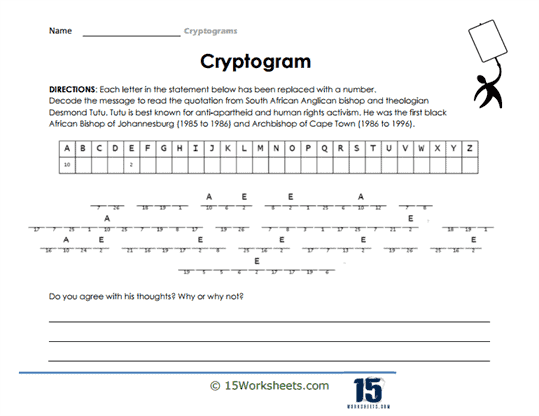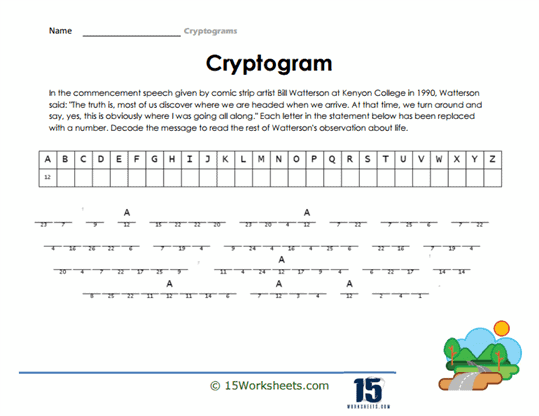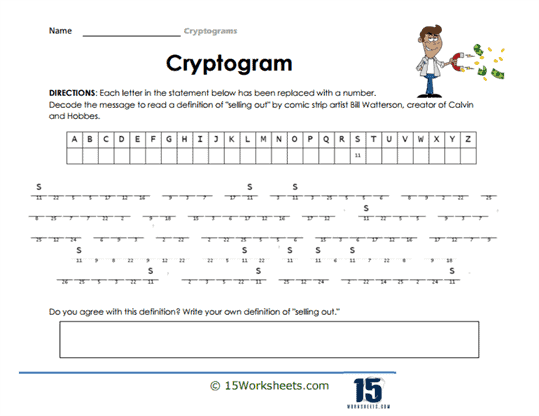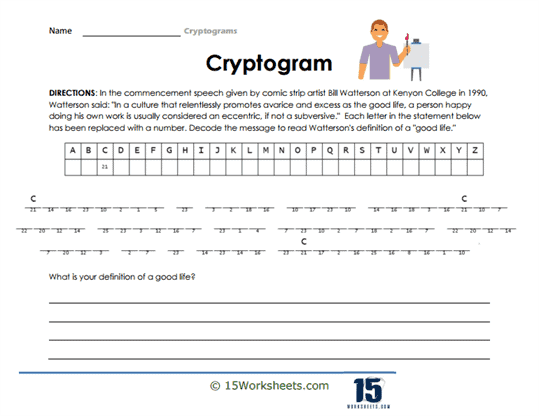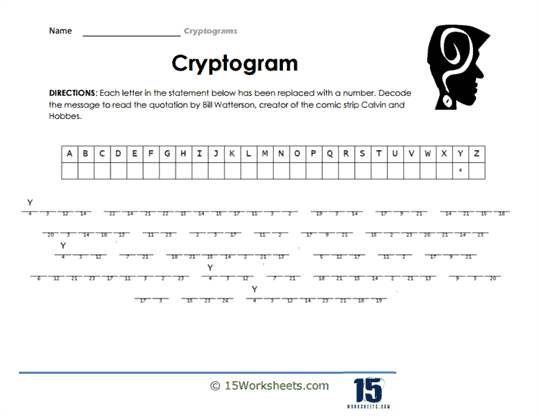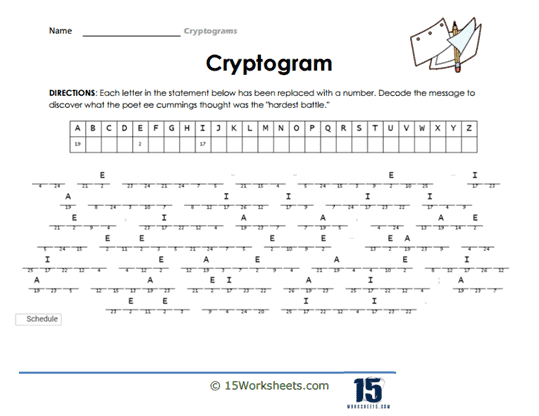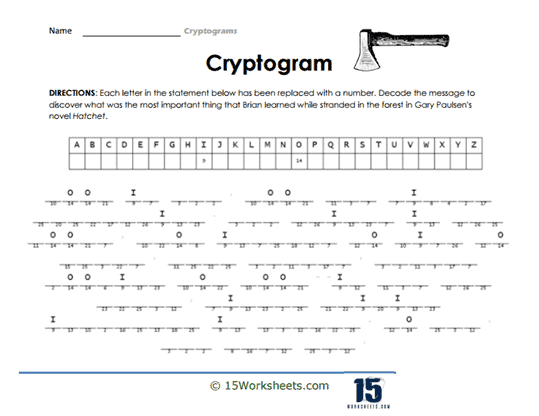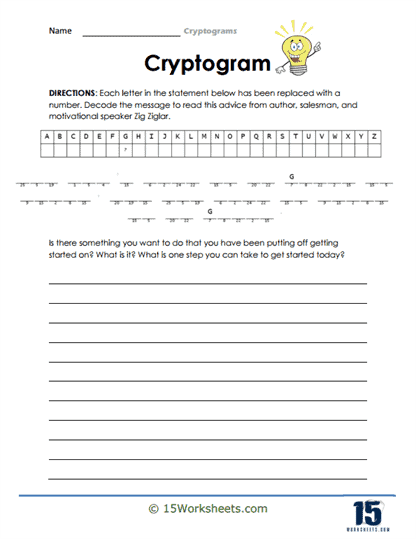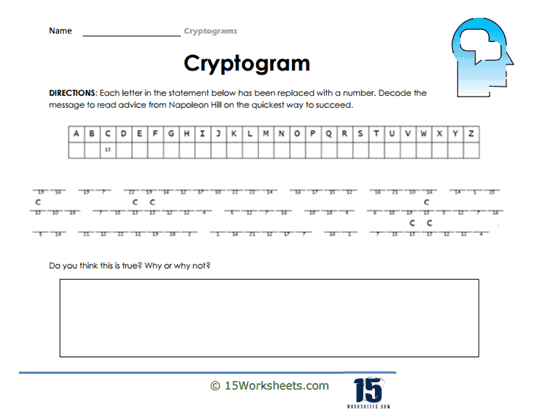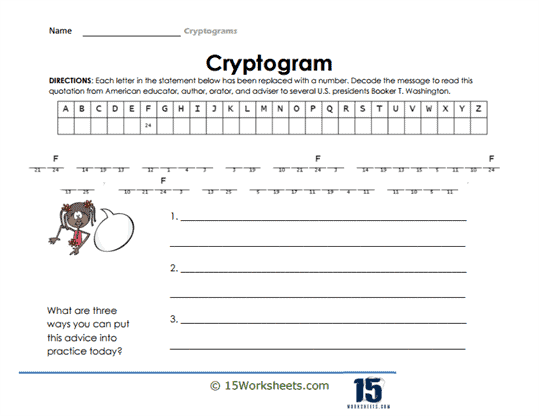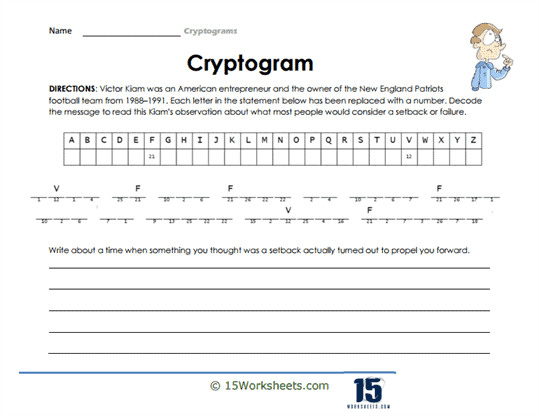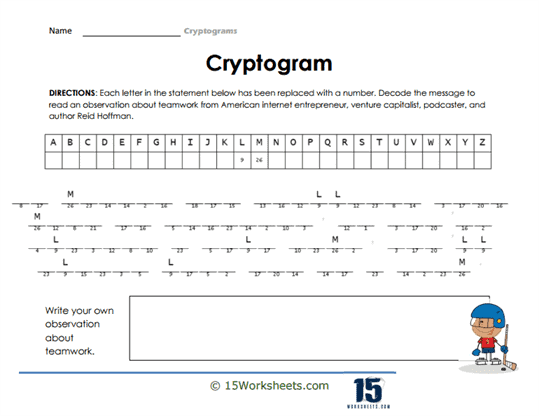Cryptograms Worksheets
All About These 15 Worksheets
This series of 15 worksheets is designed to help students learn and practice their decoding skills through cryptograms. Cryptograms are puzzles in which letters are replaced with other letters or symbols, requiring the solver to decode the hidden message. These exercises aim to reinforce students’ understanding of language and encourage them to think critically and creatively.
Learning through cryptograms can help students improve their problem-solving skills, as solving one requires them to use logic and deductive reasoning to decode the message. It also requires them to pay close attention to details, such as letter frequency and patterns, which can help improve their observation and analytical skills.
It also develops their vocabulary and spelling skills, as they must identify and correctly spell each word. This exercise can help them learn new words, as well as reinforce their understanding of spelling rules and conventions. Learning through cryptograms can help students improve their critical thinking skills. As they work to decode the message, students must consider multiple possible solutions and evaluate each one based on their understanding of language and context.
A Look At the Individual Cryptograms
Each worksheet presents a quote where letters are substituted with other letters or symbols, requiring students to apply logic and pattern recognition to unveil the hidden message. For instance, deciphering a quote from Desmond Tutu might lead students to contemplate themes of forgiveness and unity, while tackling a message from Robert E. Lee could prompt discussions about leadership and history. This method not only enhances problem-solving abilities but also encourages learners to connect with the material on a deeper level.
The collection features a diverse array of voices, from ancient philosophers like Plato to modern entrepreneurs like Reid Hoffman. Decoding Bill Watterson‘s reflections can infuse a sense of humor and creativity into the exercise, reminding students that wisdom often comes with a wink. Engaging with quotes from figures such as Booker T. Washington and Napoleon Hill allows learners to explore themes of perseverance and success.
Beyond the intellectual stimulation, these cryptograms offer moments of levity. Unraveling Zig Ziglar‘s motivational quips or Victor Kiam‘s insights on setbacks can elicit chuckles and nods of agreement, making the learning process enjoyable. The playful nature of these puzzles ensures that students remain engaged, turning what might seem like a daunting task into an entertaining challenge.
What are Cryptograms?
Cryptograms are a type of puzzle involving the decryption of text encrypted using a substitution cipher, where each letter of the alphabet is replaced by another letter, symbol, or number consistently throughout the message. Historically significant, cryptograms have been employed to secure communication during times of war or political unrest, playing a crucial role in protecting sensitive information and military strategies.
Cryptograms introduce the basic principles of cryptography, the science of secure communication. Understanding substitution ciphers and solving cryptograms can serve as a stepping stone towards more advanced cryptographic techniques. These techniques have applications in modern computer security and data protection, making the knowledge of cryptography essential in today’s digital age for ensuring secure communication and safeguarding sensitive information.
What Approach Should You Take To Solve Cryptograms?
Step One: Channel Your Inner Sherlock – Count Those Letters Like a Mad Poet.
Before you can find wisdom hidden in a jumble of alphabet soup, you’ll need to get friendly with the English language’s most popular letters: E, T, A, O, I, N…you know, the extroverts of the alphabet. Start by seeing which symbols show up most often. Is that weird triangle shape popping up like it owns the place? Might be an “E.” Or a code for extra fries. Either way, frequency is your friend.
Step Two: Single-Letter Words – The Introverts of the Vocabulary World.
There are only two solo acts in English: “A” and “I.” So if a single-letter word is giving you the side-eye in your cryptogram, congratulations-50/50 shot! If only dating were that simple.
Step Three: Find the Gang – Common Words & Patterns.
Let’s face it, some words are just clingy. “The,” “and,” “for”-these words show up everywhere, like that one guy at every party who insists he knows your cousin. Spot them by looking for letter patterns and double letters. “LL,” “EE,” “SS” – they tend to travel in pairs, like ducks or old socks.
Step Four: Digraphs, Trigraphs, and Other Fancy-Sounding Tools.
“Th,” “sh,” “ing,” “ion”…these are the Power Couples of English. If you see a three-symbol triangle at the end of a sentence, you might just be looking at “ing,” and your decoding just got easier (and more smugly satisfying). Pretend you’re solving a puzzle written by Shakespeare’s tech-savvy cousin.
Step Five: Educated Guesswork – a.k.a. Mental Gymnastics.
Once you’ve cracked a few letters, start plugging in possible words like you’re auditioning for “Wheel of Fortune: Existential Edition.” Guess a few, get a few wrong, spiral into mild despair, recover, and try again. That’s the joy of cryptograms: failure is part of the enlightenment.
Step Six: Connect the Dots – And the Letters.
As your letter map grows, the rest of the message starts to come into focus. It’s a lot like assembling IKEA furniture without the instructions-one bolt at a time, and suddenly it’s a bookshelf. Or a metaphor about self-discovery.
Step Seven: Be Zen About It. Seriously.
You will mess up. You will think “Q” is “E” and “Z” is “A” and nothing will make sense and your cat will judge you. Breathe. Backtrack. Adjust your assumptions like a wise old monk cracking dad jokes. Every cryptogram has a solution, and sometimes it just takes a few wrong turns to find the right one.
Cryptograms aren’t just about solving a puzzle. They’re about patience, curiosity, and the occasional existential crisis brought on by a mysterious “W.” But most of all, they’re fun. You’re not just decoding text-you’re unlocking wisdom, one letter at a time. And hey, if you ever feel stuck, just remember: even Plato probably had to guess a few times.

